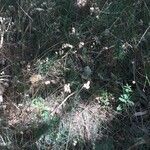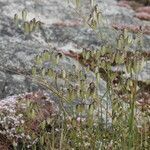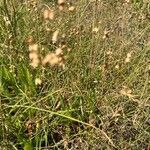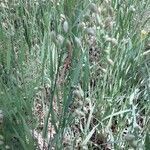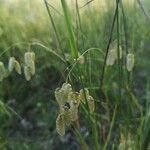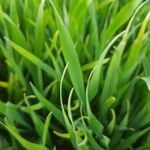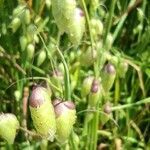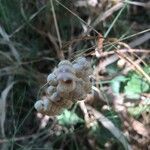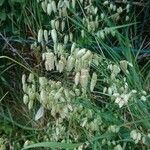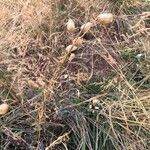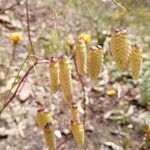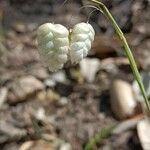Annual. Culms solitary or loosely tufted, erect or geniculate at base, 20–60 cm tall. Leaf sheaths smooth, glabrous; leaf blades thin, 4–20 cm × 3–8 mm, margins scabrid, otherwise smooth, apex acute; ligule 2–5 mm, obtuse. Panicle loose, nodding, 7–10 cm, sparingly branched with few pendant spikelets; branches inserted singly, scaberulous, sometimes with only 1 spikelet; pedicels hairlike, shorter or longer than spikelet, drooping. Spikelets ovate, ca. 1.2 × 1 cm, tinged reddish brown, florets 7–20; lower glume 5–6 mm, 5-veined, upper glume 6–7 mm, 7–9-veined, margins purple or tawny, apex broadly rounded; lemmas very broadly ovate, wider than long, lowest 7–8 mm, 7–9-veined, glabrous or appressed-pubescent; palea obovate, 1/2–2/3 length of lemma, back glabrous, keels pubescent. Anthers ca. 2 mm. 2n = 14.
Annual. Culms 18–65 cm high; mid-culm internodes hollow. Leaf blades flat, 7–19.5 cm long, 2–8 mm wide, adaxially glabrous. Panicles open, ovate, 2–7 cm long. Spikelets ovate, 10–22 mm long, with (5–) 8–15 bisexual florets; rachilla apically puberulous with clavate trichomes, with apical extension. Glumes dark brown or purplish with margins chartaceous; lower glume often broadly ovate to elliptic, 5.5–6.5 mm long, 7–9-nerved, with midnerve glabrous; upper glume obovate to elliptic, 6.25–6.5 mm long, cordate, 9 or 10-nerved, with midnerve glabrous. Basal lemma ovate, 7.5–8 mm long, entire, 9–13-nerved; nerves glabrous or pilose; intercostal regions pilose. Palea 1/2 length of lemma, 2.5–3 mm wide, truncate; nerves densely puberulous. Hilum linear.
Loosely tufted annual, 0.1-0.6(-1.0) m high; culms erect, simple or branched. Leaf blade 70-250 x 3-8 mm; ligule an unfringed membrane. Inflorescence an open panicle, appearing secund, branches single or in fascicles of 2-4; spikelets 3-12, but solitary at apices of slender branches, prettily nodding. Spikelet 8-25 x 8-15 mm, longer than wide, awnless; glumes ± equal, shorter than spikelet, green, brown or purple, 5-9-nerved. Florets 7-20, bisexual; lemma obtuse, broad, cordate at base, entire, straw-coloured, occasionally variegated with purple, sometimes minutely papillose and hairy; anther 1.0-1.5 mm long. Flowering time July-Dec. Caryopsis 2.5 x 2.0 mm.
Annual.. Culms 10–60 cm. high, loosely tufted or solitary, erect or geniculate, slender.. Leaf-blades 5–20 cm. long and 3–8 mm. wide, flat, minutely rough on the margins.. Panicles 3–10 cm. long, loose, prettily nodding, bearing up to 12 spikelets on capillary pedicels.. Spikelets 7–20-flowered, ovate to oblong, plump, 14–25 mm. long and 8–15 mm. wide, glabrous or minutely hairy, pale green, silvery, or suffused with reddish-brown or purple; lemmas 6–8 mm. long, very broad, rounded on the back, obtuse.. Fig. 19/1–12.
Loosely tufted annual, 100-600(-1000) mm high; culms erect, simple or branched. Leaf blade 70-250 x 3-8 mm. Inflorescence open, appearing secund, branches single or in fascicles of 2-4; spikelets 3-12, solitary at apices of slender branches, prettily nodding. Spikelet 8-25 x 8-15 mm, longer than wide, 7-20-flowered; glumes green, brown or purple, 5-9-nerved; lemma obtuse, straw-coloured, occasionally variegated with purple, sometimes minutely papillose and hairy; anther 1.0-1.5 mm long; caryopsis 2.5 x 2.0 mm.
Annual, loosely tufted (culms erect, simple or branched), up to 0.6 m high. Leaf blades 70-250 mm long, 3-8 mm wide. Spikelets 8-25 mm long, 8-15 mm wide. Panicle open, branches single or in fascicles of 2-4; spikelets 3-12, longer than wide, 7-20-flowered, nodding, solitary at tips of slender branches; glumes green, brown or purple, 5-9-nerved; lemmas straw-coloured, sometimes variegated with purple.
Annual; up to 0.6 m high; loosely tufted. Culms erect; simple or branched. Leaf blades 70-250 x 3-8 mm. Flowers: panicle open; branches single or in fascicles of 2-4; spikelets 3-12; longer than wide; 7-20-flowered; nodding; solitary at apices of slender branches; spikelets 8-25 x 8-15 mm; glumes green; brown or purple; 5-9-nerved; lemmas straw-coloured; sometimes variegated with purple.
Annual 2–6 dm; lvs 3–8 mm wide; ligule 2–5 mm; infl to 10 cm, secund, nodding above, with few (to 12) spikelets, these ovate, 12–20 mm, 7–20-fld; glumes 5–7 mm, 5–9-veined; lemmas 6–8 mm; 2n=14. Native of the Mediterranean region, cult. and rarely escaped in our range.
Spikelets 15-25 x 8-14 mm., 7-20-flowered, pale-green to silver-green (often especially the glumes) purplish to red-brown, broadly ovate-cordate in outline, glabrous or often shortly pilose.
Lemmas 6-7·5 mm. long, dorsally rounded, 7-9-nerved, broadly ovate, apex shortly acuminate, usually shortly pilose; the hairs tipped with glands.
Leaf-laminae 5-25 x 0·25-0·75 cm., pale-green, tapering to an acute point, usually expanded, flaccid, glabrous, scaberulous along the edges.
Glumes 5-7 mm. long, often purplish, 7-(inconspicuously 9) nerved, broadly ovate from a cordate base, apex rounded to obtusely acuminate.
An annual grass. It grows 60 cm high. The flowering stalk usually has 3-8 large spikelets. They droop at the tip.
Culms (10)20-70 cm. tall, 2-4-noded, simple, terete, slender, erect or ascending from a geniculate base, smooth.
Annual to 40 cm. Leaves linear. Spikelets 3-12 in open panicles, drooping, longer than wide, to 25 x 15 mm.
Panicles 4-10 cm. long, rather loose, with (1)3-12 Spikelets, usually pendulous; axis very slender.
Leaf-sheaths often tinged with purple, loose, striate, dorsally rounded, glabrous, smooth.
Caryopsis c. 2·5 mm. long, light brown, broadly obovate to almost circular in outline.
Pedicels up to 2 cm. long, capillary, very flexible.
Paleas with the narrow wings shortly ciliate.
Anthers 2-2·25 mm. long.
A loosely tufted annual.
Ligule 2-5 mm. long.
